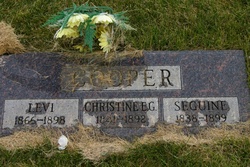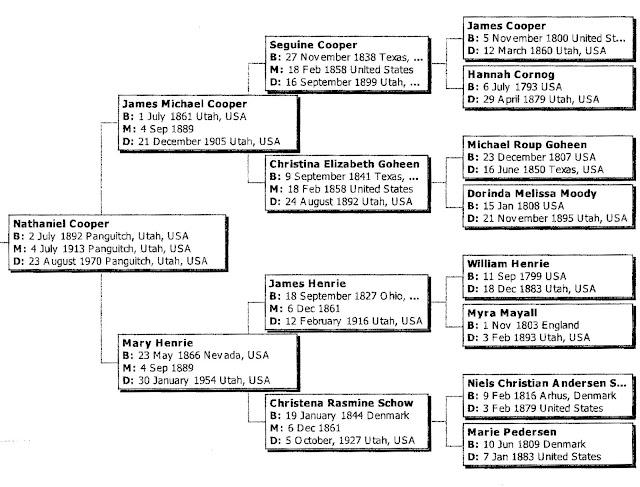Sometimes there is not much information on a particular ancestor. Such was the case of Seguine Cooper. The following history was pieced together from reading about members of his family. A great amount of information was obtained from reading the history of his daughter, Mary Ophelia. When my mother died, I found a book she had in her possession called, From Texas to Utah, The Pioneer Story of James Cooper and Hannah Cornog by J. Daniel Marshall. I was very excited to find and read this history.
Seguine Cooper was born November 27, 1837 to Hannah Cornog
and James Cooper in Spring Creek, Harris County, Texas. He was James Cooper’s only child.
His mother, a widow, had seven other children: She had four surviving “Goaslind” children by
her first marriage. From her second
marriage, Hannah had three living “Miller” children.
Spring Creek, Texas is about 20 miles north of Houston. Seguine’s father was a rancher and farmer who
owned hundreds of acres. They were quite
well off financially. They had city
property in Houston, and tracts of land in Harris and Montgomery Counties.
Seguine was in his teens when an Elder James McGaw and other
Mormon missionaries were in the area. Seguine’
father and mother were baptized in 1851.
Other members of the family were baptized the same year.
By 1853, there was growing opposition to the Mormon Church
in Texas. The Cooper family as well as
other LDS families in the area made plans to travel to Utah. Some of the members wanted to travel across
the land, a distance of approximately 2,000 miles and take their cattle with
them. They planned to travel north
following a trail where they could feed and water the cattle, until they
reached the Mormon Trail. Seguine's father, James Cooper
thought that it would be better to take a steamboat up the Mississippi River.
In the early spring of 1853, the Cooper family gave up all
their possessions in Texas, and left for Utah. They traveled across the Gulf of Mexico on board a steamship
called the “Louisiana.” They arrived in New
Orleans on April 5, 1853. From there
they went by steamboat, the “L.M. Kennet”
to St. Louis. The Coopers
traveled to Kansas City by way of the Mississippi River. There they joined the "Moses Dailey Company". James and Hannah Cooper’s other family
members and friends traveled to Utah with the "Preston Thomas Company," driving cattle from Texas to
Utah. The Coopers probably arrived in
Utah in September of 1853; some of their family members and friends arrived a year later and others arrived 3 years later.
The family settled in Ft. Herriman, west of the Jordan River,
in the Salt Lake Valley. They lived in a
little log house on a few acres of land.
He married Christina Elizabeth Goheen, a long time friend
of the family, on March 31, 1857. When Johnson’s army threatened them, they
moved to Salem, Utah. The first
daughter, Mary Ophelia was born there.
Later they went back to Ft. Herriman.
In 1863, he was called to go east to help a wagon train of Saints move to
Utah. Three
children were born to Seguine and Christina while the family was living in Ft.
Herriman: Seguine Goheen in 1858, James
Michael (our ancestor) in 1861, and Dorinda Christina*
in 1863. Seguine’s grandmother, Hannah Cornog Cooper, also lived with them since her husband died in 1860.
In 1866, James’ family was called to settle the St. George
area. Many families who had come from
the Southern States were called south to the “Cotton Mission” because they knew
how to raise cotton. The Cooper family
was originally called to settle the ”Muddy Mission” beyond St. George, near
present day Las Vegas,Nevada.
They left their home in Ft. Herriman taking only their family and
what supplies they could haul in two wagons.
The wagons pulled by six oxen, were loaded with their belongings, seed
for planting, and enough food to last a whole year.
The Coopers traveled with several other families who were also
called south. Seguine drove a covered
wagon pulled by four oxen while his daughter Mary drove the lighter wagon
pulled by two oxen. Mary drove this
second wagon because her mother was expecting their fifth child any day.
When they reached the settlement of Beaver in November 1866,
Christina delivered a baby boy they named Levi. They waited a few days before continuing
their journey.
They continued on traveling south from Beaver to St. George. Christina looked forward to seeing her
mother who lived in Washington, Utah.
She hadn’t seen her mother for eight years. The children had never met their grandmother,
Dorinda Moody Goheen Slade. The family
stayed there for a few days before moving on.
The Cooper family traveled to St. George and found out that their call to the
“Muddy Mission” was changed. They were
now to travel about a week’s journey to the north until they reached a new
Mormon settlement of Panaca which was located about 90 miles west of Cedar
City, Utah. Two children were born in
Panaca: Eliza Jane in 1868, and Hannah
Melissa in 1870.
Panaca was originally settled by Mormon families six months before Nevada
became a state. Soon there were miners
in the area. There were some problems
between the miners and the Mormons and also with the Indians. The state line for Nevada had been changed
putting Panaca in the State of Nevada rather than Utah. Nevada wanted the taxes that had been paid to
Utah up to that time. The taxes were
high and the settlers were unable to pay.
After living in the Panaca area for five years, the Cooper family left
to settle one of the communities in Southern Utah.
In 1871, Seguine Cooper left his family in Panaca and drove his wagon to the
Panguitch Valley arriving in April. He
made preparations for his family to move there.
He then returned to Panaca to move his family, his livestock and what
possessions he could fit into a wagon.
It took about a week to travel from Panaca to Panguitch.
When the family arrived in Panguitch on August 10, 1871, there had been a hard
frost the previous day. His wife and
mother saw everything frozen and expressed their doubts about living at that
high elevation. The elevation of Panguitch is
6,700 feet. They also thought that
since Panguitch was on the north side of the mountains, it would be
colder. The women were concerned about
the area being too cold to raise good crops, but Seguine told them to look at
the range available for livestock. There
were lakes and streams for fishing and much wildlife in the area. He convinced them to settle in
Panguitch. Seguine’s job in the
community was that of fisherman.
At this time, the Cooper family consisted of Seguine, his wife and mother, and
seven children. The first year they
lived in Panguitch, they lived in the Panguitch Fort located on the corner
where the high school now stands. The
fort and stockade were made of long posts set closely together. The houses built inside the fort faced the center,
and each house had holes cut in the back walls, large enough to shoot a rifle
through.
In the spring of 1872, the Cooper family, now totaling ten people, moved out of
the fort and into a little log house several blocks away. The house had only one large room, a board floor, no rugs, and no ceiling. It was
cold in the winter, so the fire was kept burning day and night for months. Apples and potatoes not taken back to the
cellar at night were frozen so hard the next morning that they couldn’t be used
until they were thawed by the fire.
Their meals consisted mainly of meat, potatoes, molasses, dried
peaches, and milk. In the summertime
they often ate wild dandelion greens and pig weed greens with their meals. During the winter of 1877-78, the people in
Panguitch had a hard time feeding their families. They lived on such foods as wild wheat,
barley, potatoes, squash, onions, corn, and beans. Dried corn, ground and boiled before serving,
was called hominy.
Clothes were also scarce during the winter.
Most of their clothing was worn out, so pants for the children were made
from flour sacks and other sacks. The
lack of food and clothing made life tough.
Seguine Cooper's house in Panguitch was located a block west of Main Street. It later became the location of the J. Scott Haycock home, and eventually the Kirk Moore home.
In 1873, some Panguitch people began to homestead land at Panguitch Lake. Seguine built a cabin on his homestead at the
lake. The Cooper cabin was near the east
shore of the lake at the foot of what is now known as “Cooper Peak,” although
it is labeled as “Cooper Knoll” on today’s Forest Service map. The cabin stood in a more level area, now
usually covered with water, which is south of where the Lake View Resort now
stands. In the early days, very few
people tried to live at the lake year round.
It was extremely cold at night with temperatures often reaching about 35
degrees below zero. Snow drifts could
reach up to eight feet deep. Sleeping
outside on the ground or in a wagon was then very common, even in town. This wasn’t sleeping out for recreation as
much as it was a lack of room indoors, and it wasn’t limited to the summer
season. The family consisted of Seguine, his mother, his wife, and ten children. Three children were born in Panguitch: Amanda Fredonia in 1873, John Harvison in 1876,
and Nathan Cooper in 1879.
 |
| Photo by A. Bell - Findagrave.com |
Seguine Cooper died on September 16, 1899 in Panguitch and is
buried in the Panguitch Cemetery.
*All of Seguine and Christiana's children are buried in Panguitch except their daughter, Dorinda. Where she is buried, is unknown. See Dorinda for blog post about her story.
Information taken from book, From Texas to Utah, The Pioneer Story of James Cooper and Hannah Cornog, by J. Daniel Marshall.








